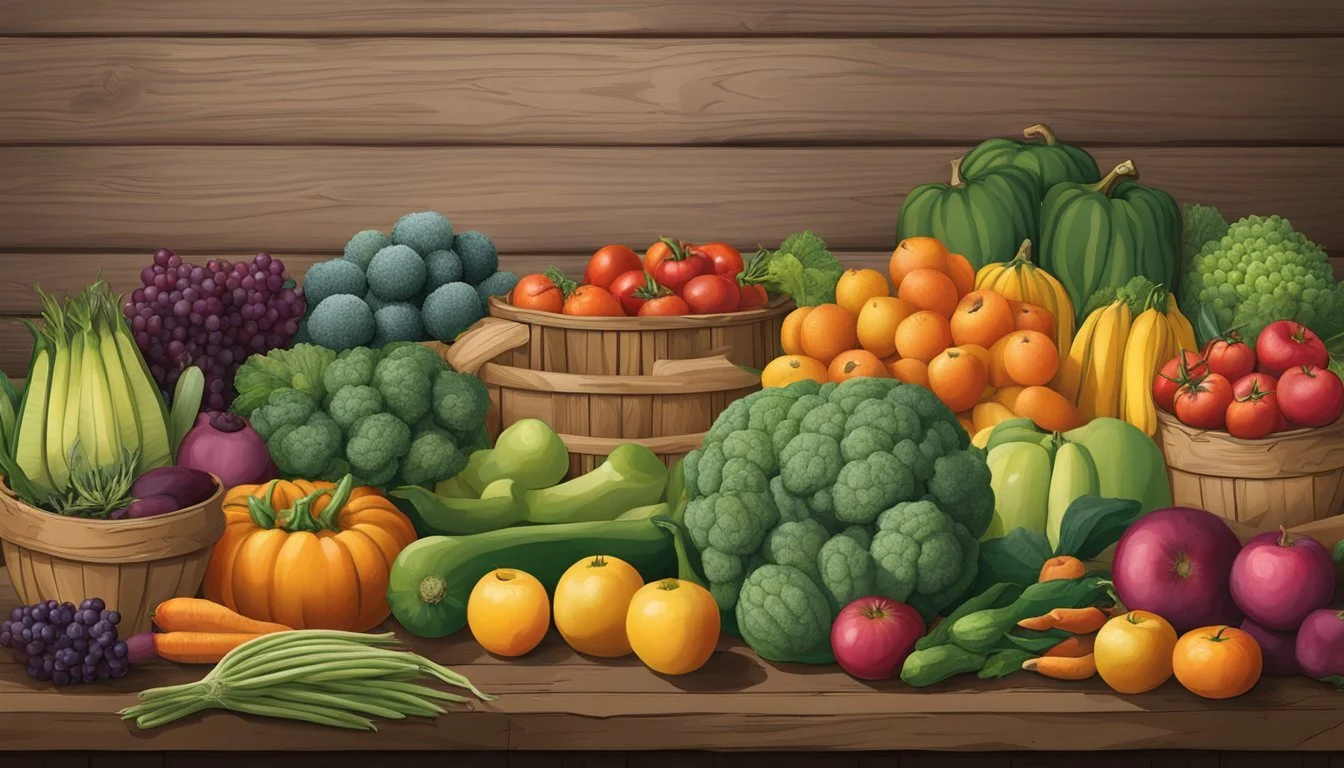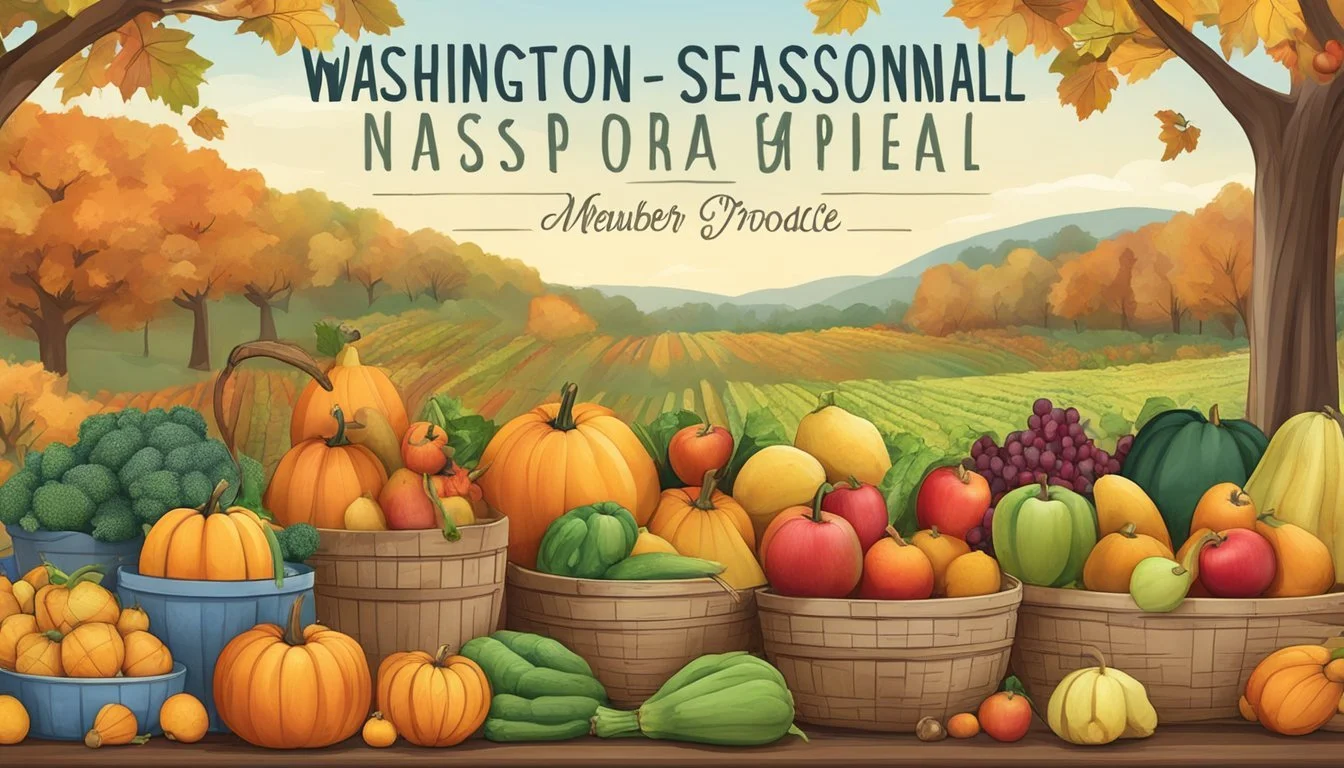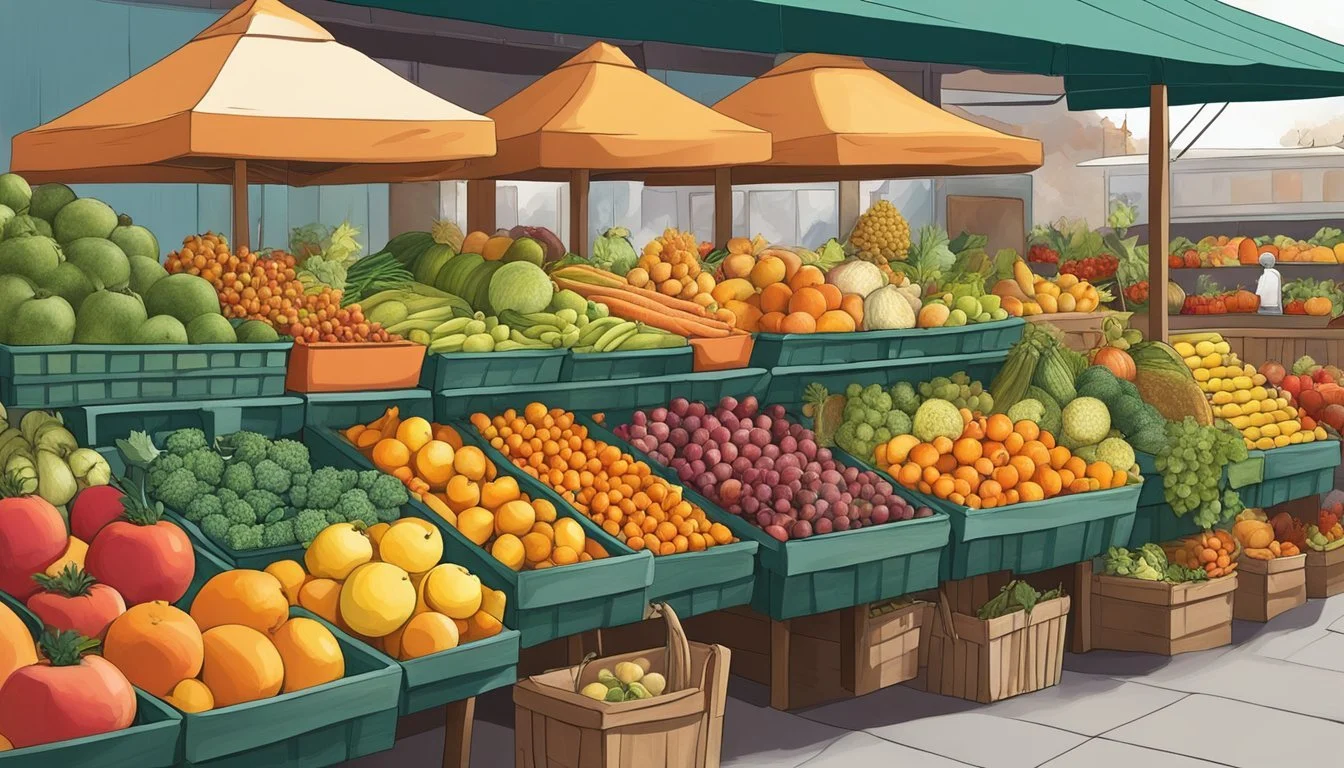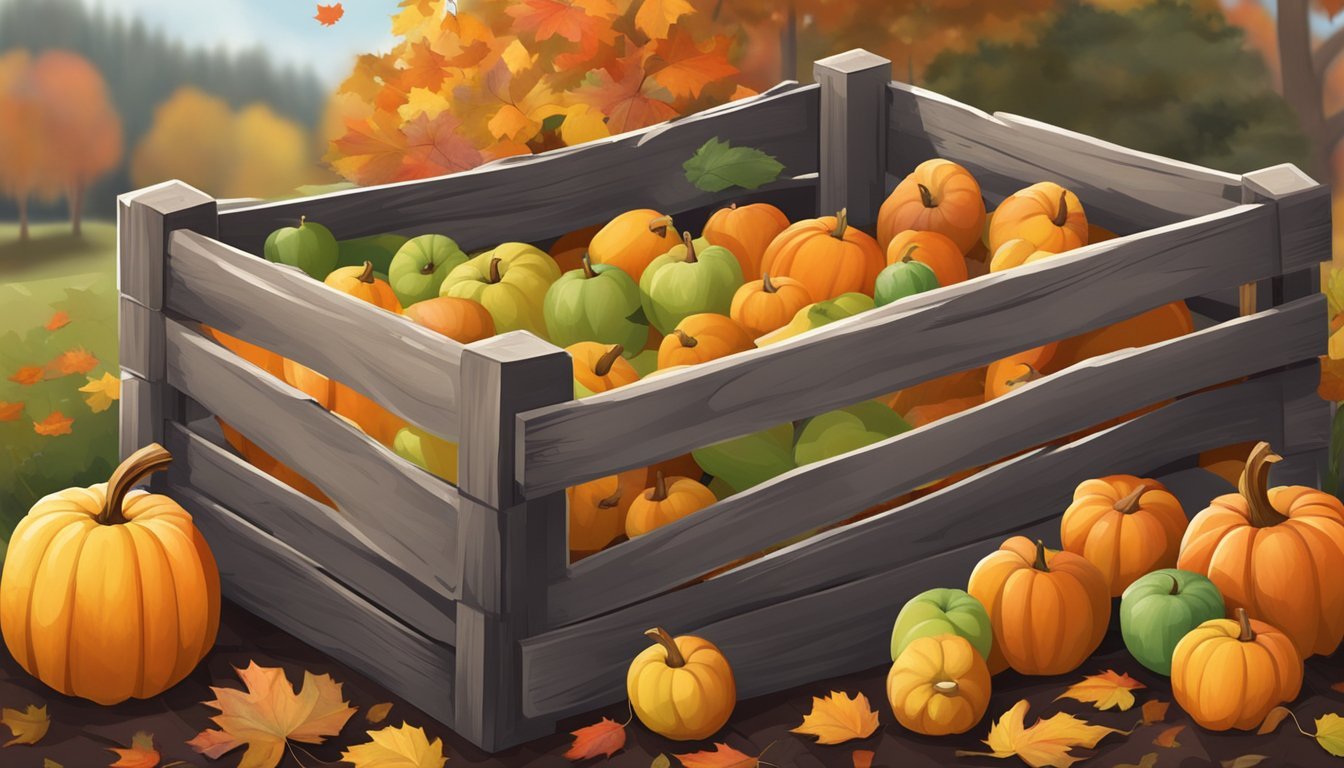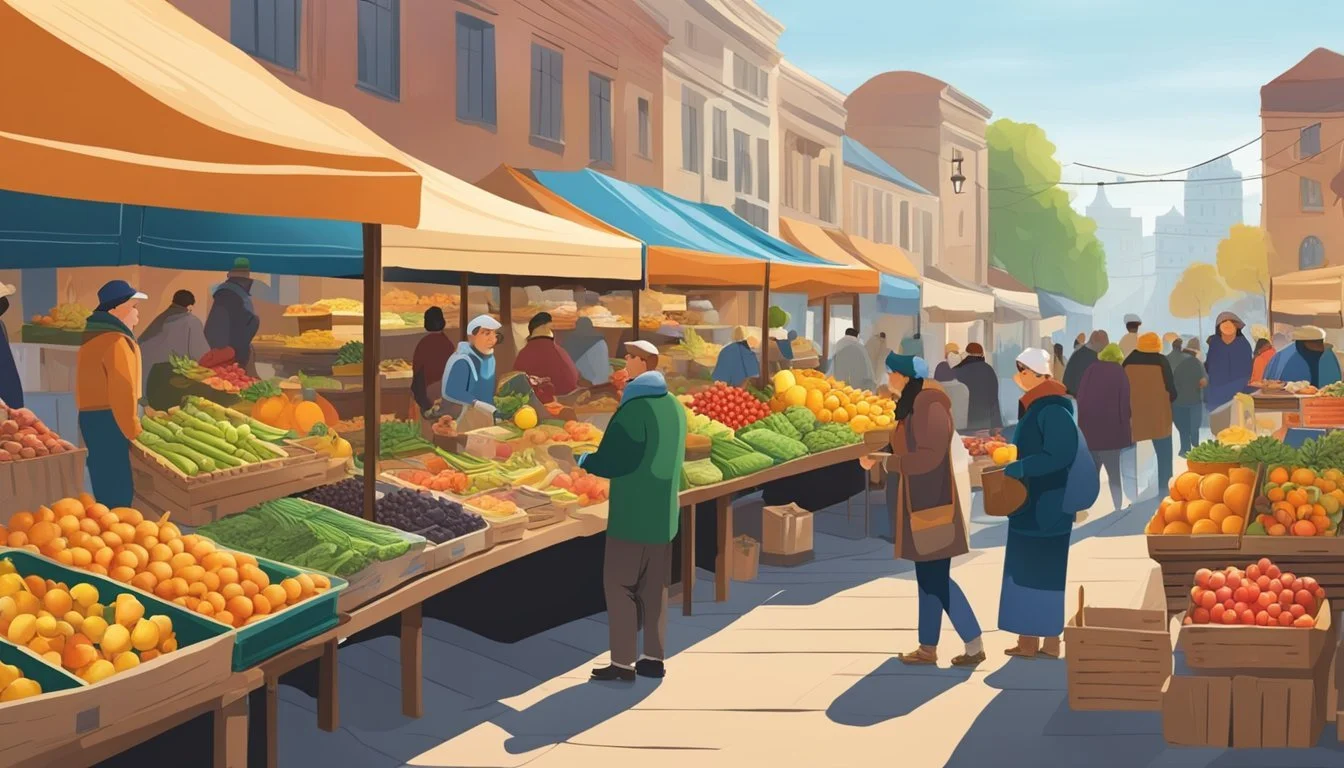Washington Seasonal Fruit & Vegetables in November
Your Guide to Fresh Produce
This Article is Part of our Washington Seasonal Fruit & Veg Calendar
Washington's climate and fertile soil allow for a rich variety of fruits and vegetables to flourish. November, being late in the fall season, is a time when the state’s produce offerings begin to transition from the vibrant berries and stone fruits of summer to hardier winter crops. In this month, residents and chefs alike can take advantage of the last harvests of certain autumnal vegetables, while beginning to see the emergence of produce that thrives in the cooler temperatures.
The selection of vegetables in November includes robust greens like kale (What wine goes well with kale?) and Swiss chard, root vegetables such as beets, carrots, and parsnips, and winter squash—all of which can withstand the dropping temperatures. These vegetables are not only seasonal but also offer the nutrition and flavors suited for hearty, warming dishes that are synonymous with late fall.
Fruits, on the other hand, are less abundant in Washington during November, as many summer varieties have ended their season. However, apples and pears are typically still available, providing sweet and tart options for desserts, preserves, or fresh eating. These fruits, staples of Washington agriculture, are celebrated for their quality and variety and continue to be available thanks to the state’s diverse apple and pear orchards, which harvest many types during the fall season.
Seasonal Overview
In Washington, November marks the transition from the vibrant fall harvest into the early whispers of winter. The focus shifts to robust, cold-tolerant produce that can withstand the chill.
Understanding Seasonality
Seasonality is essential in determining the availability of produce in Washington. As the season turns from fall to winter, the types of fruits and vegetables available are those that have adapted to thrive in cooler temperatures. Shoppers looking for the freshest, locally sourced food will discover a selection that reflects the seasonal shift. This includes roots and hearty greens that are less sensitive to the cold snap.
November's Seasonal Palette
Fruits:
Apples
Pears
Vegetables:
Beets
Brussels sprouts (how long do brussels sprouts last?)
Cabbage
Carrots
Cauliflower
Chard
Collard greens (how long do collard greens last?)
Garlic
Kale
Leeks
Onions
Parsnips
Potatoes
Pumpkins
Squash (winter varieties)
Turnips
The rich array of vegetables available in November is indicative of Washington's agricultural resilience. With the cooling temperatures, farmers switch their focus to crops that not only survive but flourish in this climate, ensuring a diverse selection for consumers.
Fruits in Season
November in Washington presents a bountiful harvest of late-autumn fruits, with a diverse range of flavors and textures. The crispness of apples and pears shines during this month, while select berries offer a final burst of sweetness. Exotic fruits also find their way into the local markets, providing a tropical twist to the fall fruit palette.
Types of Apples
Honeycrisp: A crisp, sweet variety that is perfect for snacking.
Fuji: Offers a dense flesh with a sugary flavor.
Granny Smith: Known for its tartness and firm texture, ideal for baking.
Varieties of Pears
Anjou Pears: These are juicy and have a subtly sweet flavor with a hint of citrus.
Bosc Pears: Recognizable by their brown skin, they have a honey-sweetness and a firm texture that holds up well in cooking.
Late Autumn Berries
While most berries have ended their season, some late-harvest types remain available:
Cranberries: Tart and vibrant, often used in sauces and baking.
Exotic Fruits Availability
Persimmons: Smooth, honey-like flavor when fully ripened.
Pomegranates: Juicy, ruby-red seeds that are bursting with tart sweetness.
Kiwi: A tangy yet sweet fruit with a unique texture, available in grocery stores.
Vegetables in Season
Washington's November harvest offers a bountiful selection of vegetables that thrive in the cooler weather. This month showcases a variety of root vegetables, cruciferous selections, leafy greens, and robust winter squashes.
Root Vegetables Galore
November is prime time for Washington's root vegetables. Onions and beets are in abundance, offering sweet and earthy flavors perfect for hearty autumn dishes. Carrots bring a splash of color and a touch of sweetness to the table, while parsnips, turnips, and rutabagas provide a wide range of textures and tastes well-suited for roasts and stews. Sunchokes also make their seasonal appearance, known for their nutty flavor and crisp texture.
Cruciferous Vegetables
Brussels sprouts and cauliflower are the stars in the cruciferous vegetable category during November. They are versatile and can be prepared in a multitude of ways, from roasting to steaming. These vegetables not only add a depth of flavor to any meal but also come packed with important nutrients and health benefits.
Leafy Greens Varieties
The chill of November welcomes a variety of kale, a leafy green renowned for its nutritional value. Kale can be found in numerous varieties, offering a range of flavors and textures, from curly to flat and mild to peppery. It holds up well in cooking and is a popular addition to soups and sautés.
Winter Squashes
An array of winter squash hits its peak in November, including butternut, acorn, and spaghetti squashes. Their rich, sweet flesh is ideal for baking, pureeing for soups, or simply roasting. Sweet potatoes (What wine goes well with sweet potatoes?) also come into season, providing a versatile and nutritionally dense option for both savory and sweet applications.
Herbs and Seasonings
In Washington, November ushers in a season where robust herbs and aromatic seasonings become invaluable for culinary applications. Among these, sage and garlic stand out for their potency and versatility in the fall palate.
Aromatic Additions
Sage is a quintessential herb in November, renowned for its earthy and slightly peppery flavor. It complements a variety of dishes, particularly those featuring poultry and root vegetables. Sage's robust leaves are often used whole in roasting or finely chopped for stuffings and sauces.
Garlic remains a staple in the November kitchen with its bold, pungent flavor that can transform any dish. Available both fresh and stored, garlic is utilized broadly across cuisines and pairs well with the hearty fare of the season.
When discussing herbs in general, one should note that while some tender herbs may dwindle as the weather cools, hardy varieties like rosemary and thyme continue to thrive and are often available fresh in November. They are best used to infuse deeper flavors into soups, stews, and roasted dishes (What wine goes well with roasted dishes?).
Sage: Earthy, peppery, excellent for poultry.
Garlic: Bold, pungent, versatile across dishes.
Hardy herbs: Rosemary, thyme, continue to flourish.
The availability of these herbs provides home cooks and chefs alike with the opportunity to create depth and complexity in their autumnal dishes.
Culinary Inspirations
November's harvest in Washington provides a bountiful palette of flavors and ingredients, allowing for a rich tapestry of culinary creations. These ingredients serve as the foundation for warm, hearty dishes and the preservation of autumn's bounty.
Seasonal Recipes
Roasted Root Vegetables: A medley of November’s fresh root vegetables, such as parsnips, potatoes, and sweet potatoes, can be tossed with olive oil, seasoned with herbs, and roasted to create a simple but flavorful side dish.
Sweet Potato Salsa: Utilizing the sweet profile of sweet potatoes, a chef might combine them with traditional salsa ingredients like tomatoes and onions, adding a unique sweetness to the zesty salsa blend.
Cooking Techniques
Baking: She might take advantage of November's fresh pumpkins by creating tender, spiced pumpkin bread. Baking highlights the natural sweetness of pumpkins, converting it into comforting, seasonal treats.
Roasting: Roasting Brussels sprouts and root vegetables concentrates their flavors. It can also transform the natural sugars present in these vegetables, enhancing the overall taste and introducing a delightful caramelization.
Preserving the Harvest
Canning: He could prepare preserves and pickles with the late autumn harvest. By canning, they extend the life of peak-season flavors, such as making beet relish or pickled radishes, both savory and sweet.
Freezing: They often freeze berries and stone fruits harvested earlier in the year. This ensures that the fresh flavors of blueberries and blackberries can be enjoyed long after their traditional growing season has passed.
Agricultural Practices
Washington's diverse agricultural sector during November incorporates practices that prioritize both ecological balance and crop productivity. Farmers across the state employ techniques that adhere to strict organic standards while also focusing on sustainable harvesting to ensure the longevity of the land that provides the bounty of the season.
Organic Farming
Organic farming practices maintain soil integrity and ecosystem health by eliminating the use of synthetic fertilizers and pesticides. Farmers in Washington cultivate a variety of crops using organic methods, particularly apples and root vegetables that are in season during November. They rely on:
Natural composts and manures for fertilization
Crop rotation to preserve soil health
Biological pest control using beneficial insects
The harvest of organically grown crops provides consumers with options that support their preference for minimally processed foods.
Sustainable Harvesting
Sustainable harvesting methods are employed by Washington farms to ensure that the production of vegetables and fruits is viable year after year. Sustainable practices include:
Selective picking to minimize plant stress
Water conservation techniques, such as drip irrigation
Minimized tillage to protect soil structure
Farmers are deeply aware that sustainable approaches during the harvest months contribute to the preservation of the farm's productivity for future seasons.
Availability and Access
In November, residents of Washington have access to a variety of fresh, locally-grown fruits and vegetables through different channels. These include farmers' markets, grocery stores with farm-sourced selections, and Community Supported Agriculture (CSA) programs. Each platform offers seasonal produce, ensuring that consumers can enjoy the richness and taste of Washington's harvest.
Farmers' Markets
Farmers' markets are a mainstay for accessing fresh produce directly from the source. November selections may be limited compared to the summer months, but consumers can still find local vendors offering hardy greens, winter squash, and late-harvest crops like:
Apples: Available in several varieties
Pears: Including local favorites like Bosc and Anjou
Root Vegetables: Carrots, parsnips, and beets
Winter Greens: Such as chard and kale
Grocery Store Selections
Grocery stores often stock up on local produce to meet consumer demand for fresher, sustainable options. In November, grocery store selections typically include:
Winter Squash: Acorn, butternut, and spaghetti varieties
Potatoes: A staple in many households, available in multiple types
Onions and Garlic: Essential for flavoring winter dishes
Brussels Sprouts: Gaining in popularity and seasonally fresh
The variety in grocery stores can depend on the store's commitment to local farmers and seasonal produce.
Community Supported Agriculture (CSA)
CSAs are integral in providing consumers with regular deliveries of fresh, local produce. By subscribing to a CSA in November, members will likely receive:
Leafy Greens: Including late harvest lettuces and spinach
Root Vegetables: A mix that often includes turnips and radishes
Herbs: Like parsley and cilantro, weather permitting
Preserved Goods: Such as pickles and jams, to complement the fresh offerings
CSAs support local agriculture and provide a direct connection between farmers and consumers, reinforcing the local food economy.
Health and Nutrition
When it comes to health and nutrition, Washington's seasonal produce in November offers a wide array of dietary benefits. Rich in essential nutrients, these fruits and vegetables are an integral part of a balanced diet.
Dietary Benefits
Fruits such as apples and pears are abundant in November. They are high in fiber, which aids digestion, and rich in vitamin C, essential for a robust immune system. These fruits are also packed with antioxidants, which are known to combat free radicals and promote general health.
Vegetables available during this month include Brussels sprouts, carrots, and winter squashes like butternut or acorn squash. They are particularly nutrient-dense and offer a variety of health benefits:
Brussels sprouts are high in vitamins K and C, and studies suggest they may have properties that can help protect against certain cancers due to the presence of glucosinolates.
Carrots are well-known for their beta-carotene content, which the body converts into vitamin A, vital for good vision and skin health.
Winter squashes provide complex carbohydrates and fiber, helping to regulate blood sugar levels, and are rich in vitamin A, vitamin C, potassium, and magnesium.
Incorporating these green and nutritious foods into one's diet supports a healthy lifestyle and can be a vital part of maintaining a balanced diet. These foods not only contribute to overall health but also to the sustainability of local agriculture.
Seasonal Challenges
November in Washington presents distinct challenges for fruit and vegetable production, chiefly due to weather patterns and supply chain variations that impact availability.
Weather Impacts
Washington's climate in November transitions into winter, with colder temperatures and increased precipitation posing challenges for growers. Frost can threaten late harvest crops, and early snowfalls may disrupt the harvesting of robust winter vegetables. The need for protective measures, such as crop covers or greenhouses, becomes essential.
Temperature: Sudden drops in temperature can endanger crops still in the fields.
Precipitation: Excessive rain can lead to waterlogged soil, complicating harvesting and potentially promoting disease.
Supply Variations
The supply of fresh produce in Washington during November may face fluctuations. Storage capacity and distribution efficiency become pivotal in ensuring continuous availability. Some crops may be in shorter supply, leading to an increased reliance on stored goods or imports.
Storage Crops:
Apples: Stored varieties maintain supply post-harvest.
Root vegetables: Well-suited for long-term storage.
Distribution Network:
Roads: Inclement weather can disrupt transport routes, delaying shipments.
Markets: Demand may outpace supply as local production dwindles, possibly increasing prices.
Preservation and Storage
Washington's abundant harvest in November necessitates effective preservation and storage techniques to extend the life of the produce and ensure quality. These methods vary depending on the type of fruit or vegetable.
Extending Shelf Life
For fruits and vegetables harvested in November, canning and freezing are popular methods to prolong shelf life. Canning involves placing fruits and vegetables in airtight containers and is ideal for acidic produce, such as apples and pears. Freezing, which is suitable for both fruits and leafy greens, requires blanching vegetables first to preserve texture and flavor.
Proper Storage Methods
Storage conditions must be tailored to each type of produce:
Root vegetables: Store in a cool, dark place with high humidity to prevent drying out. Examples include potatoes and beets.
Apples: Keep at a low temperature and high humidity, separate from vegetables.
Leafy greens: Refrigerate in a sealed container with a damp cloth to maintain moisture.
By employing these preservation and storage methods, one can maximize the longevity and taste of Washington's seasonal offerings.
Food Community and Events
In Washington State during November, the food community comes alive with events and educational programs that celebrate the season’s bounty. These gatherings aim to strengthen community ties and enhance both culinary skills and knowledge.
Local Food Festivals
Washington Apple Festival: They celebrate one of the state's most iconic fruits with tastings, contests, and family-friendly activities. This community event highlights the importance of apples in Washington's agriculture and brings together local producers and consumers for a festive occasion.
Pumpkin Harvest Fest: They provide a platform for local farmers to showcase their pumpkin and squash varieties. Food stands offer seasonal treats, and culinary competitions engage the community in celebrating the harvest.
Cooking Classes and Workshops
Seasonal Cooking Workshops: Local chefs offer classes focused on creating dishes from November’s seasonal produce, like beets, Brussels sprouts, and sweet potatoes. The workshops aim to educate participants on the versatility of these ingredients and how to maximize flavor.
Canning and Preservation Classes: They guide attendees on how to preserve the fall harvest. These sessions often include hands-on opportunities for participants to learn traditional techniques of food preservation, ensuring they can enjoy local flavors year-round.





